The Circle Elm and the Library Oak : Two Landmark Campus Trees
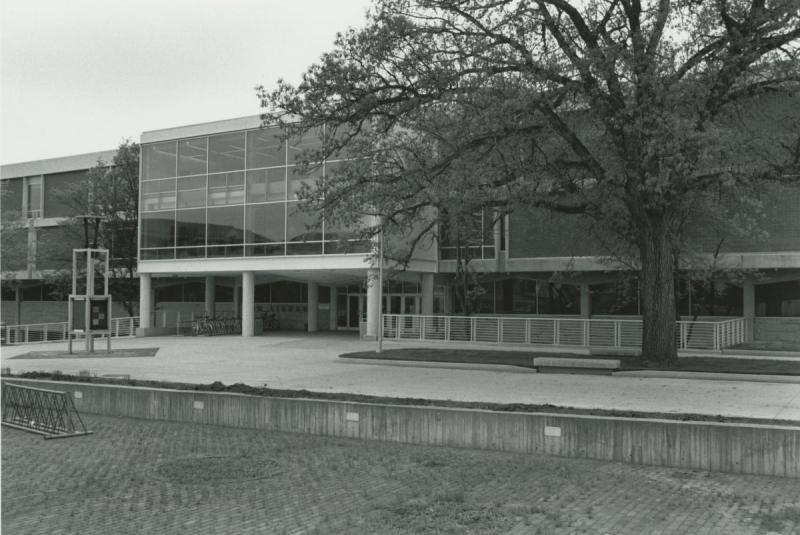
The Circle Elm
Most of the original forty acres of the University of Northern Iowa campus was clear, un-wooded upland when the school opened in 1876. However, several early writers noted that there were at least some trees on campus. There were silver maples in the low, damp southeast corner in front of what is now Seerley Hall. There were "junipers" (possibly red cedars) in the area on the south side of campus about where Sabin Hall now stands. And there were maples and ashes in the area where Bartlett Hall and the East Gym were later built.
But for the first ninety years of UNI history, the predominant tree on campus was the American elm (Ulmus americana). Elm saplings, planted along the front drive, appear in the earliest campus photos.
Faculty and students tended the elms carefully during those early days. Maude Gilchrist, daughter of the school's first principal, James Cleland Gilchrist, remembered her father saying to a group of students after supper, "Well, boys, those elms need water." He then led the "boys" to the eastern part of campus with a bucket of water in each hand.
American elms were wonderful shade trees. They grew quickly into large, graceful, vase-shaped specimens. The UNI campus, especially the area along College Street, became a shady haven with tall elms arching over pleasant sidewalks and roads.
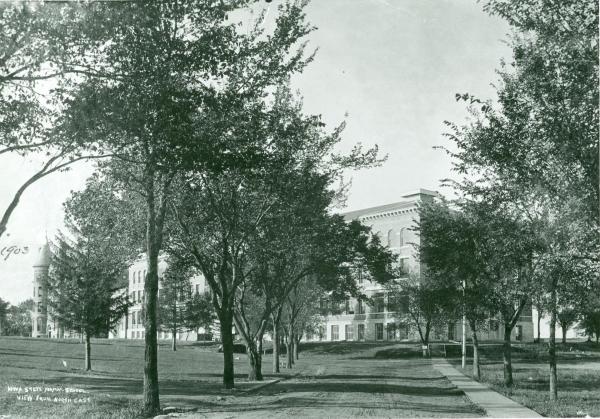
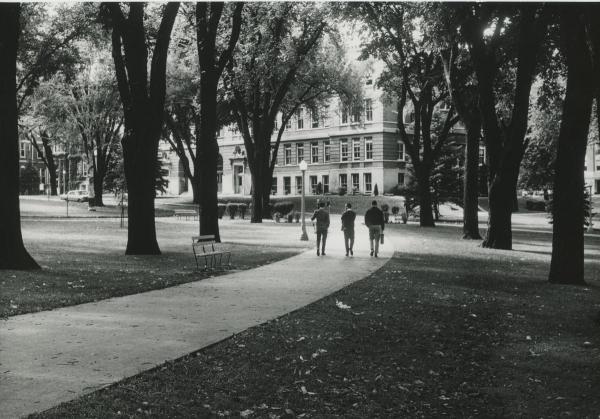
Elms were easy to grow and beautiful in their maturity. Consequently, it is not surprising that when Physical Plant Director E. E. Cole made a count in 1957, he found that 540 of the 602 campus trees, nearly ninety per cent, were American elms.
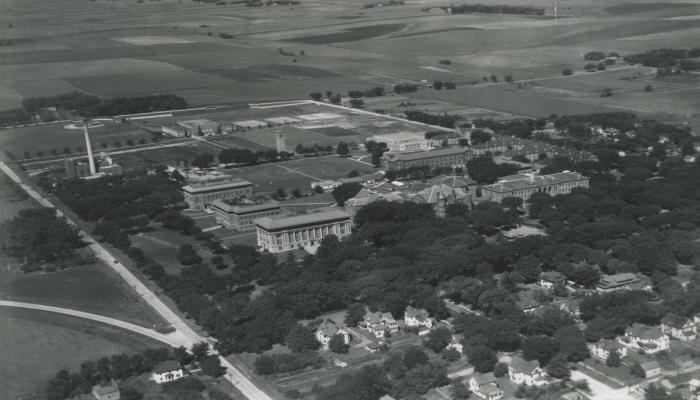
One campus elm attained landmark status. This handsome, relatively solitary tree became known as the Circle Elm, because, in the latter part of its life, it stood in the Back Circle, a pleasant, park-like area now occupied by the Maucker Union.
However, the Circle Elm had not always grown in a landscaped, manicured park. The Circle Elm probably began its life during the earliest days of the Normal School in the 1870s. Since the elm grew in the campus "backyard", though, where athletics and military drill took place, there are no early photos of it.
The earliest datable photo that clearly shows the elm was taken during a student cadet drill at a Commissioning Day Ceremony in 1892.
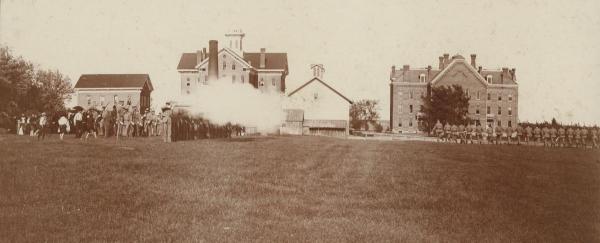
At that time, the elm stood about twenty-five or thirty feet high. (Compare it to the original Gilchrist Hall behind it.) It was still a bushy, dense young tree, possibly fifteen years old.
Another military drill photo was shot about ten years later.
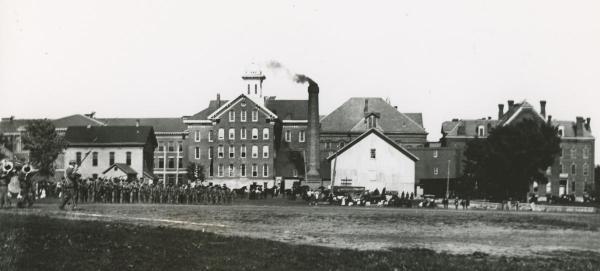
The elm had grown ten to fifteen feet taller by the time of this later photo. It had also begun to assume the vase shape characteristic of mature elms. The elm, however, was not quite as large or dense as it may appear in this photo. There is another elm behind the Circle Elm that gives the illusion of deeper and denser shade.
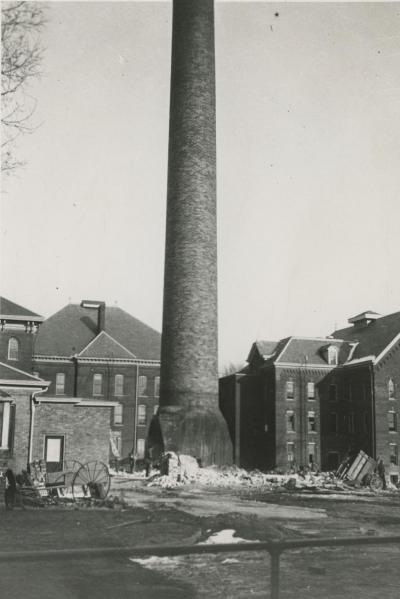
Until the early 1930s, the central part of campus served distinctly utilitarian purposes. Stables, sheds, supplies, equipment, warehouses, athletic fields, parking lots, and the power plant were all located where the Maucker Union and the Rod Library now stand. During the ten year interval between the two military drill photos, the campus power plant was re-built. The old smokestack was demolished and a new stack was built a little farther south and closer to the Circle Elm.
And, since the power plant burned coal, there was a large coal pile in the center of campus most of the year. That coal pile often extended quite close to the Circle Elm. By the late 1920s, half of the elm's drip-line was in a parking lot; the other half was in the coal storage area. These were terrible growing conditions, but the elm survived. In 1933, a new power plant on the southern edge of campus was completed. The old central campus plant was demolished.
At about the same time, the school undertook a landscaping program that improved the appearance of many parts of campus. Some of the large evergreens near the Campanile are products of that program. The central campus area formerly occupied by the power plant and the coal pile also received the attention of the landscapers. Workers laid diagonal concrete walks and planted a few spruces and spreading junipers in this area. But the dominant element of the landscape was the tall elm, then about sixty years old.
Through the 1940s and 1950s, a walk to class across the Back Circle, as it came to be known, was an everyday part of most students' lives. For those with cars, there was even a limited amount of parking available along the edges of the pleasant grassy area.
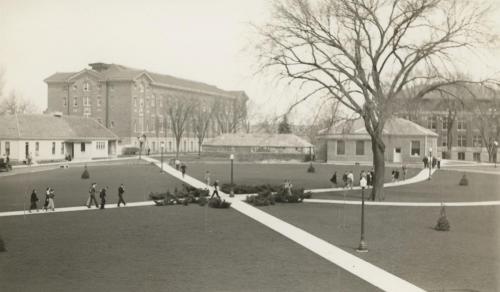
This open area extended clear back to the Campanile and, beyond that, to the West Gym. It was UNI's nearest approach to a college quadrangle.
With the completion of Phase One of the Rod Library in 1964, however, this open prospect was closed. The new building had the effect of completing the enclosure of the Back Circle with substantial academic structures.
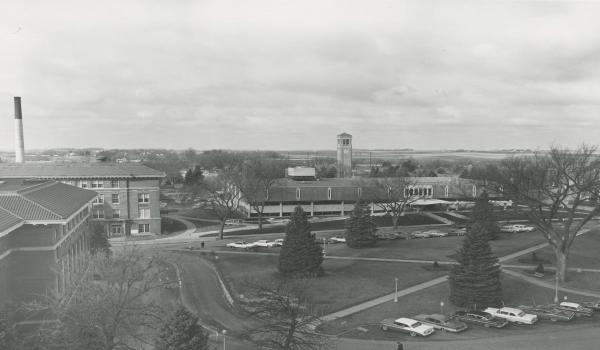
Library construction took place far away from the Circle Elm and did it no harm. But the next construction project in the central campus core would devastate the Circle.
Since its completion in 1933, the Commons had served as the student union. By the 1960s, the school needed a much larger and more modern facility. University planners selected the Back Circle as the site for the new union. They believed that the Circle's central location made it a natural site for a student facility. Many students and faculty protested when they learned of these plans. During the 1965-1966 school year they circulated petitions against the Circle site. Donald Howard, a respected member of the history faculty, proposed alternate locations. But the protests were in vain. The Regents reaffirmed that the prime central location of the Circle made it the best site for a student union.
In the spring of 1967, the large spruce trees, then about thirty-five years old, were dug up and transplanted.
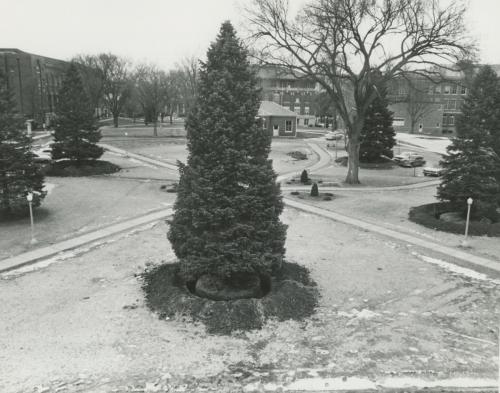
Several of those transplants, including the tree that became the campus Christmas tree, survived until quite recently. The Circle Elm, however, was cut down and hauled away. It was probably about ninety years old. The Circle was cleared and the Maucker Union was built.
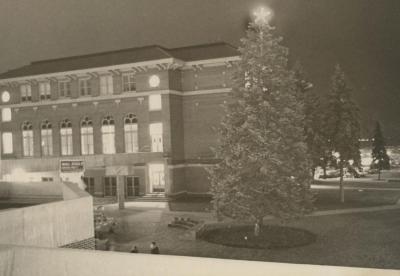
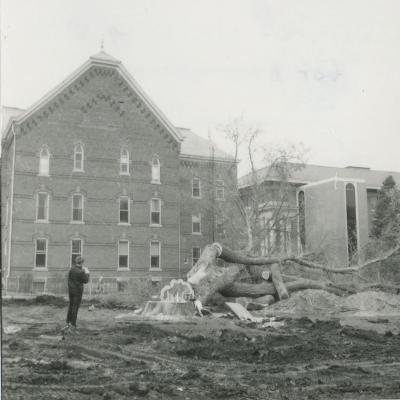
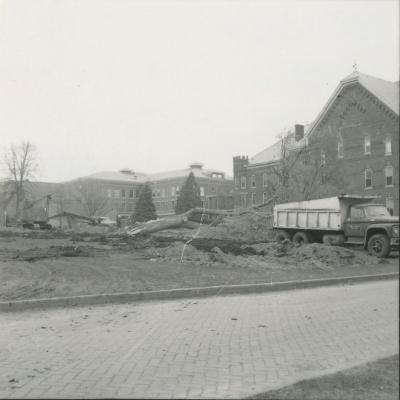
In all likelihood, construction of the Union shortened the life of the Circle Elm by only a few years. Dutch elm disease, in its deadly march across campus, would almost certainly have killed the Circle Elm. The disease reached Iowa in 1957. President Maucker sought professional advice and organized a campaign to fight it.
Physical Plant staff trimmed broken branches, cabled large limbs together, and removed suspect trees. There was initial optimism that the disease could be controlled. But ultimately it was a losing battle. By 1963, the disease had reached the campus neighborhood. By 1966 many campus trees were infected.
Within just a few more years, nearly all mature elms in the campus area were dead and gone. Many people who lived in the Midwest during that time remember the roar of chainsaws as the background noise in their lives for months on end. By the early 1970s, the campus had the stark appearance of a clear cut forest.
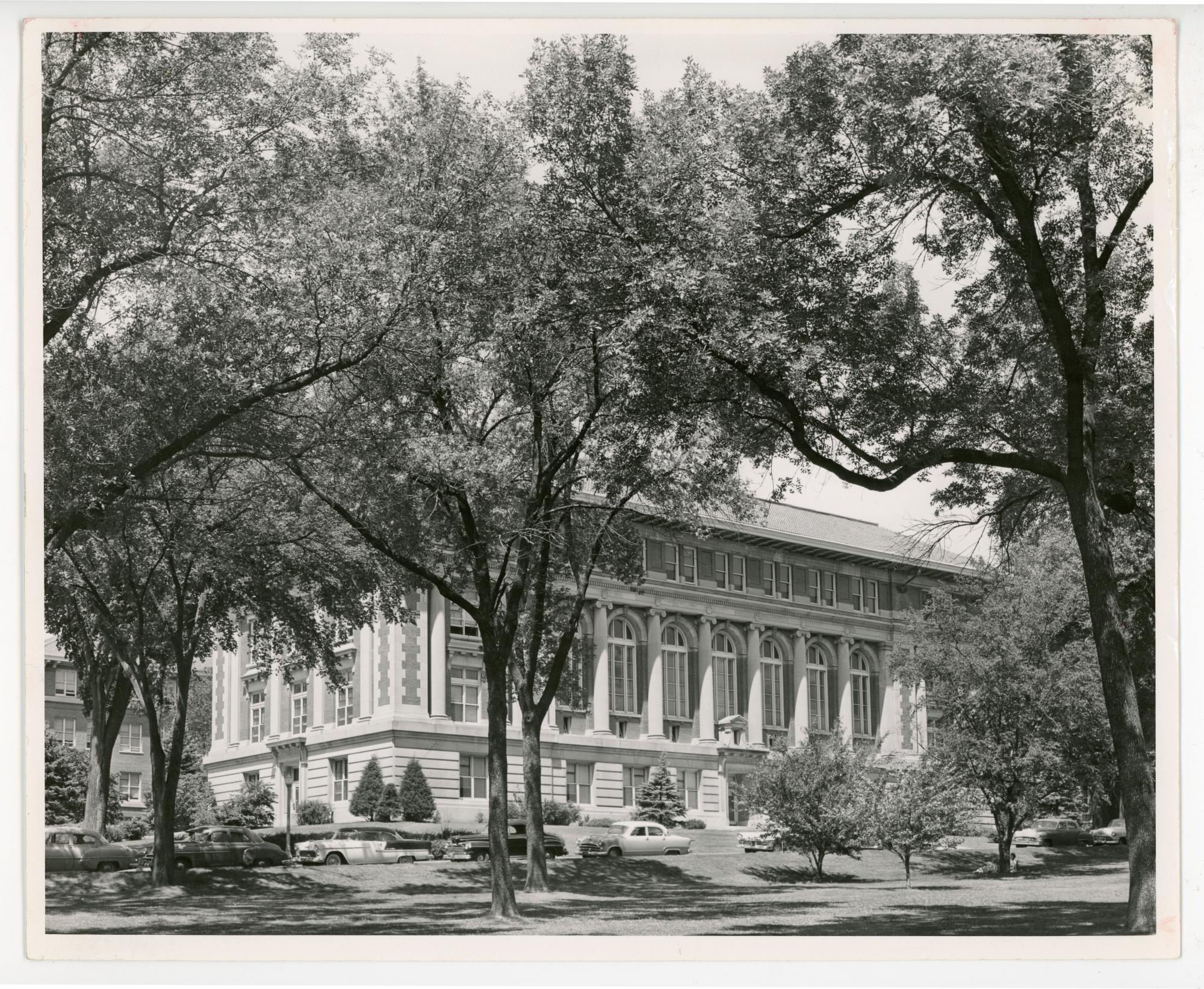
The Library Oak
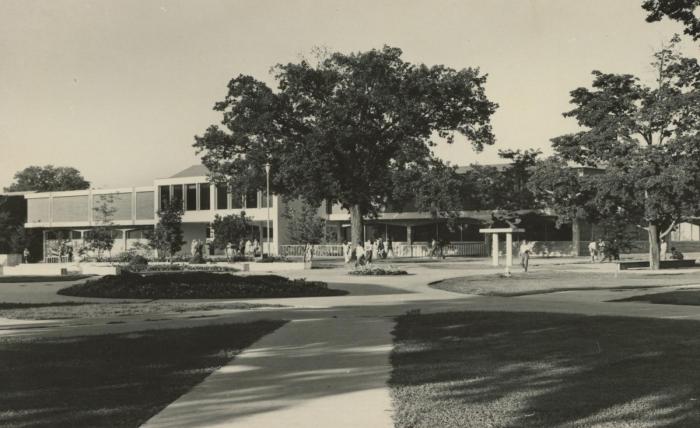
As a consequence of Dutch elm disease and the lack of diversity in its landscape plantings, the UNI campus today has only a few large trees. There is a nice double row of pin oaks, none planted earlier than the 1930s, between the Campanile and the West Gym. There is a large soft maple in the low area south of the President's House. There are also some large ash trees, probably planted in the late 1890s, in front of Seerley Hall. However, almost certainly no tree now standing on campus was here when the school opened in 1876.
One of the finest large trees remaining on campus is the oak in front of the Rod Library. This beautiful example of the swamp white oak (Quercus bicolor) has survived many years of foot traffic, construction, and other disturbances to become a campus landmark. It is difficult to say exactly when the library oak began its life on campus. The tree does not appear in photos from the 1890s or the early 1900s.
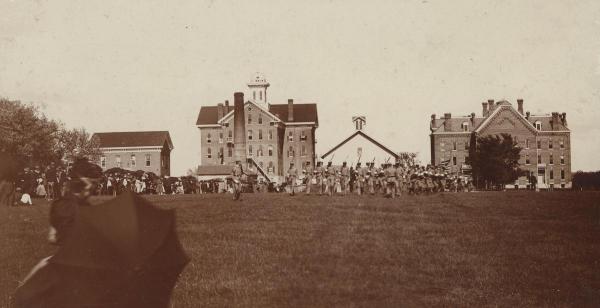
In those days the area where the tree and the library now stand was the school's "backyard" and playing field. Students participated in athletics and military drill in this area.
A gymnasium, completed in 1904 and now known as the Innovative Teaching and Technology Center, was the first building erected in this area.
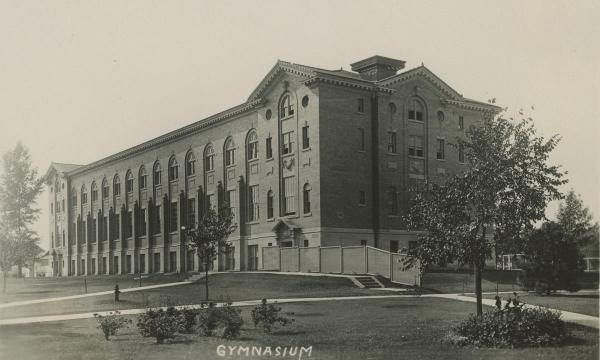
At that same time, a small "temporary" frame building for Domestic Science classes was built just south of the Gymnasium. It stood a little in front of where the northeast corner of the Library now stands. This temporary building probably provided the reason for the planting of what is now the library oak.
The Domestic Science building was built in the shape of the letter "C", with the arms of the "C" pointing west. These arms framed a little yard sheltered on three sides by the building. Not long after this building was completed, a small tree appears in photographs of this yard.
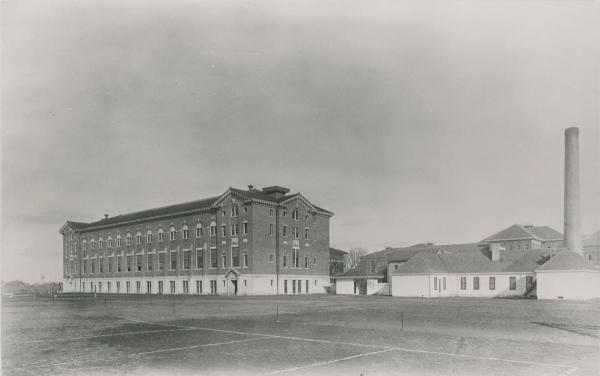
Citation: "East Gym and Domestic Science Building," 1910, in the University of Northern Iowa Photograph Collections, box "BUI - Golf Course - Gymnasium East" folder "Gymnasium - Exterior", University Archives, Rod Library, University of Northern Iowa.
The precise date that the tree first appears cannot be determined because there are few photos of this part of campus during this time. However, it is reasonable to estimate that the first photo in which the tree appears was taken around 1910.
Given the disturbance caused by the construction of the Gymnasium and the Domestic Science building and the lack of oak trees in the vicinity, it is unlikely that the tree was a volunteer that happened to germinate in a fortunate location. Rather, it is likely that it was planted there intentionally, perhaps to provide shade from the setting sun and shelter from the west wind.
The oak prospered in this location. By the middle to late 1920s, the oak stood about fifteen feet tall and already gave a little shade to the Domestic Science building.
From the middle 1920s through the early 1940s, the Teaching Department ran a nursery school in this building. The best close-up images of the oak during these years occur in photos of the nursery school and its activities. The oak made excellent growth during this period. Early nursery school photos show a healthy, but still obviously young tree. Late photos show the oak beginning to assume the shape of a mature tree. During this time the diameter of the trunk also increased remarkably.

Aerial Views offer another perspective on the oak. A shot from about 1930 shows the dark leaves of the oak peaking over the roof of the white frame Domestic Science building near the top center of the photo. This photo also gives a good idea of the proximity of the Circle Elm to the old power plant.
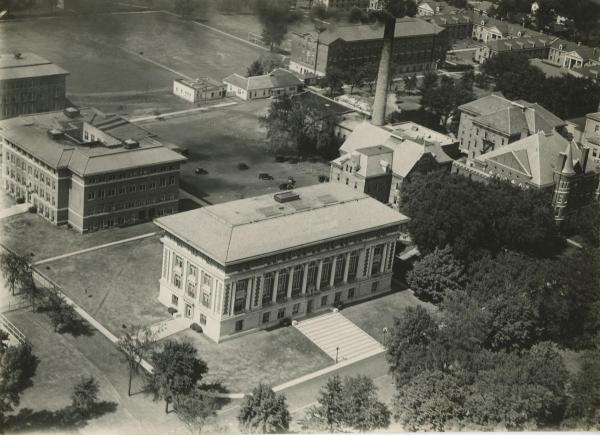
An aerial view from the late 1930s shows the new power plant in operation on the left of the photo and the old power plant site cleaned up and landscaped.
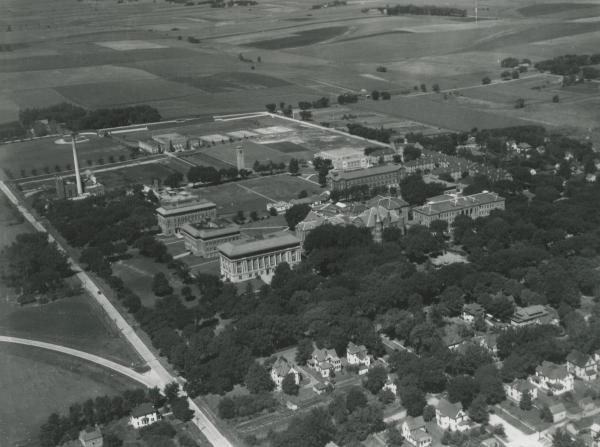
An aerial view from the early or middle 1940s shows that the first phase of Lawther Hall has been completed and that O. R. Latham Stadium has a permanent grandstand. The oak shows a little wider spread.
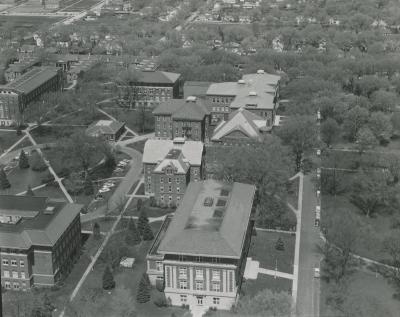
A significant change occurred in the oak's neighborhood in May 1954. After fifty years, the "temporary" Domestic Science building was demolished.
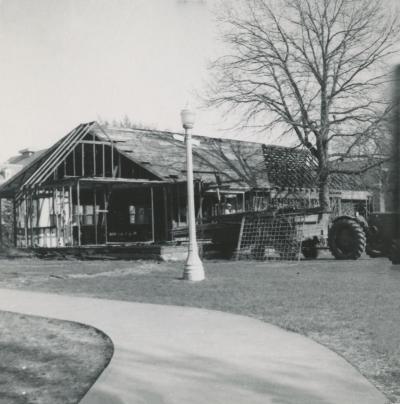
The oak became freestanding and visible from all sides for the first time. An aerial view from about 1960 shows the Circle Elm at left center and the oak standing relatively isolated to the left of the East Gym.
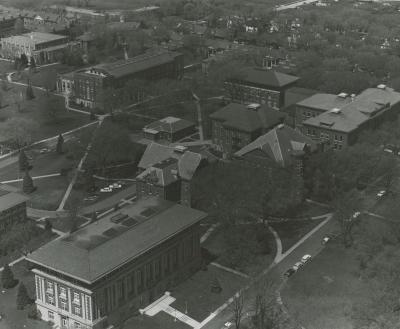
The oak did not stand isolated for long. In 1963, construction began on Phase One of the Rod Library. Excavation for the foundation and the east window wells extended very close to the oak's drip-line. The construction company built its saw shed just a few feet away from the oak's trunk. Heavy equipment and concrete walks compacted soil and altered drainage near the oak.
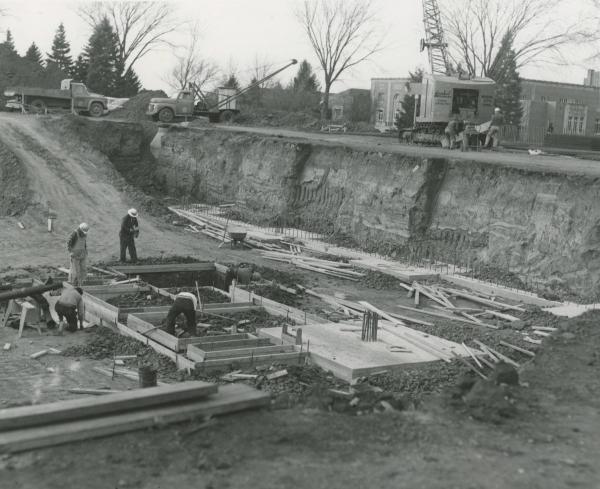
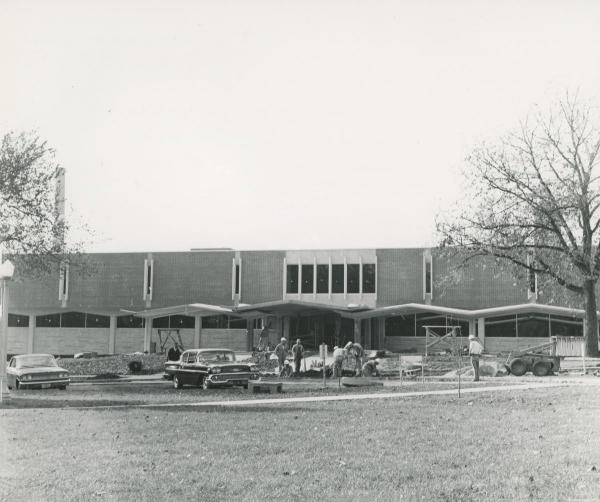
The oak survived all this disturbance and quickly became a featured photographic subject. The oak's location near the northeast corner of the Library helped to frame and soften the lines of the new library building.
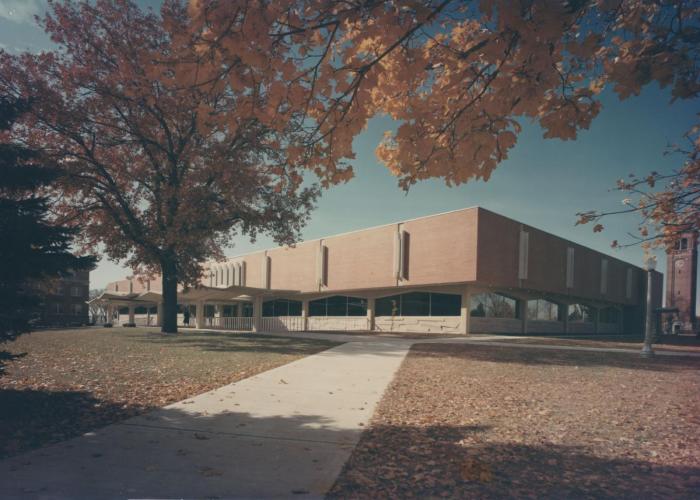
For the years between the completion of Phase One of the Library in 1964 and the beginning of the construction of Maucker Union in 1967, the oak was on the edge of the pleasant central campus park known as the Back Circle.
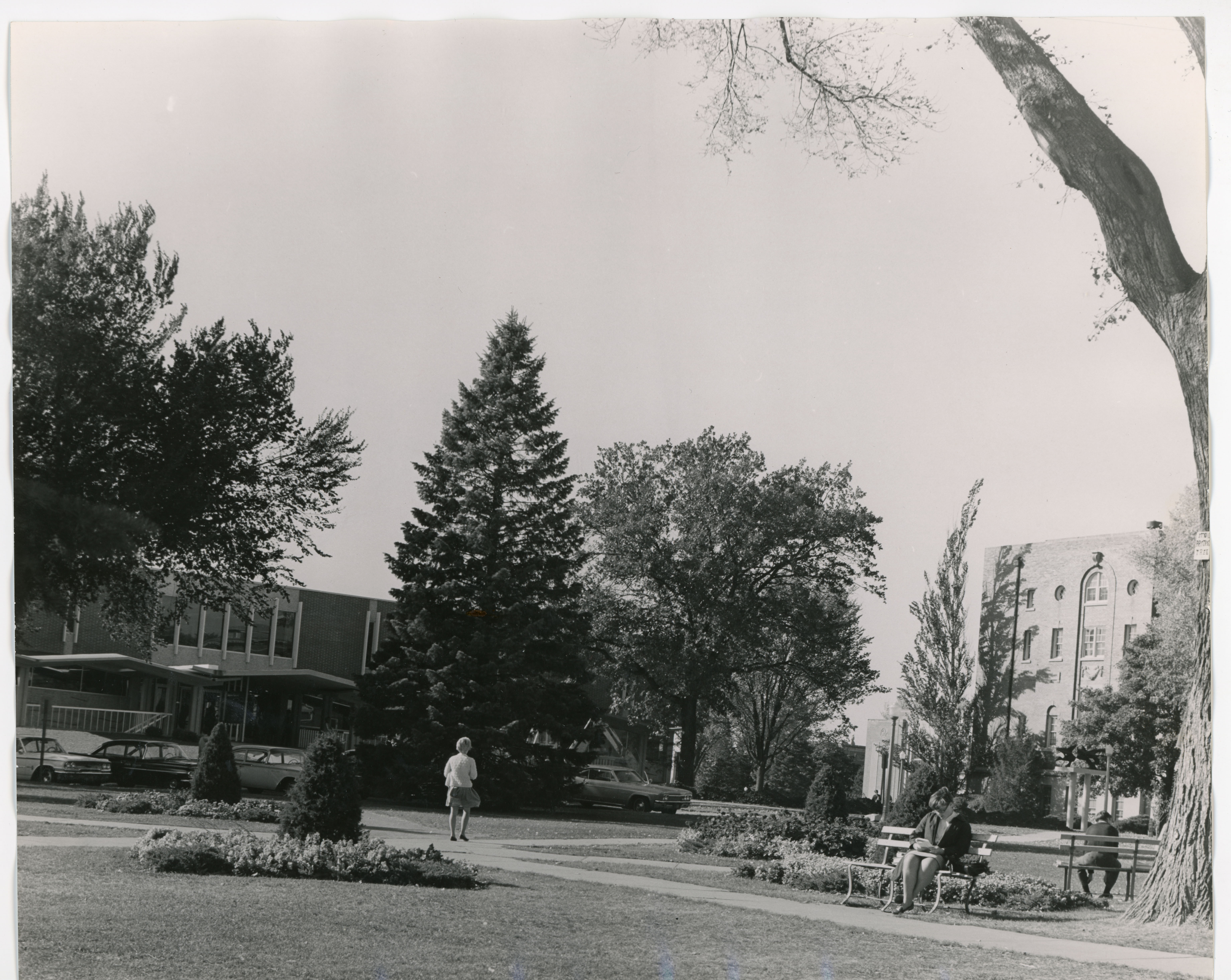
With the completion of the Union in 1969, the immediate surroundings of the Library Oak took on their current appearance. Most of the area between the Union and the Library was paved. Green space was severely limited. The oak was confined to a small grassy area of a little over 1000 square feet.
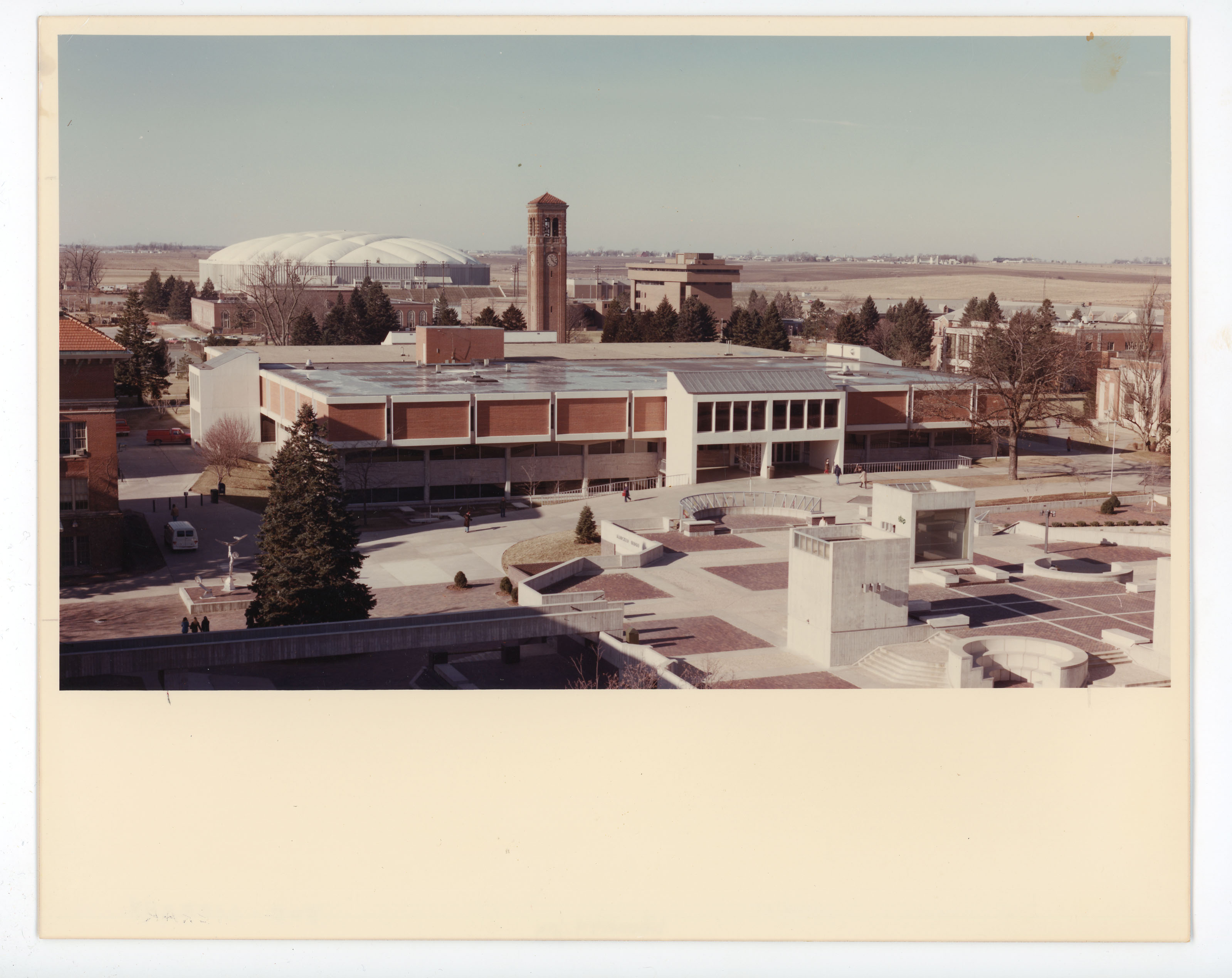
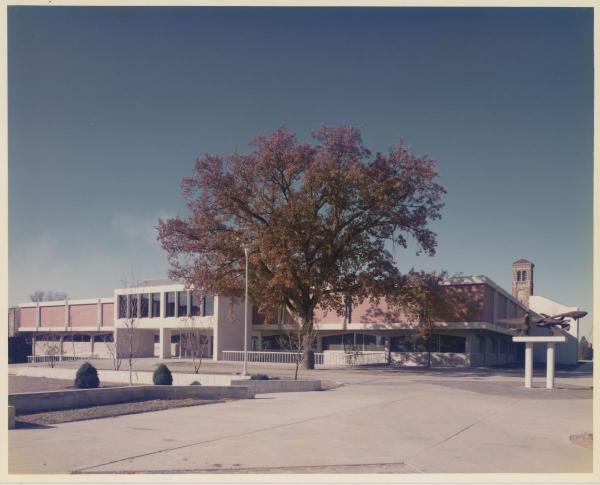
The Library Oak has lived under difficult conditions for the last forty years. The surrounding concrete sidewalk and plaza reflect heat and limit the amount of water that can reach the oak's roots. Replacement of most of the surrounding concrete sidewalk with brick pavers in 2010 might help with water retention. The Library's east window well limits the spread of the oak's roots. Lightning struck the oak during a thunderstorm one night in the late 1970s. The curved scar from that strike, with some apparent decay, is still clearly visible on the south side of the trunk. The curbing installed in 1995 is a mixed blessing: it discourages casual foot traffic, but it shunts rainwater from the walks away from the oak.
Yet the oak seems to be in good health. It leafs out fully and produces a crop of acorns every year with the loss of only an occasional small branch. It does not seem to be increasing its spread much in recent years, but the diameter of the trunk seems to increase a little. Despite being located in a tiny, isolated island of green in a sea of hard surfaces, the oak continues to appear in many university publications.
The Library Oak is probably about one hundred years old. That is about the age of the Circle Elm when it was cut down. If the oak gets enough water, if it is not disturbed by further construction, if it can avoid disease, it has the potential to survive for many years to come.
Botanical advice by Reference Librarian Chris Neuhaus; scanning and Web coding by Library Assistant Susan Basye; photo selection and essay by University Archivist Gerald L. Peterson, January 1998; last updated April 24, 2015 (GP). Images updated by Lydia L. Pakala May 31, 2019.
